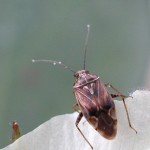I’ve received a few calls on adult tarnished plant bug migration into squaring cotton. Silking corn, blooming soybeans and flowering pigweed all contribute to large increases in plant bug numbers that make their way to ThryvOn and non-ThryvOn cotton. ThryvOn’s bt gene can help reduce the amount of injury plant bugs inflict to squaring cotton but adults, especially large numbers of adults, can knock squares off of ThryvOn just like non-ThryvOn. I’ve seen ThryvOn cotton go from 90 plus percent square retention to sub 50 percent in 5 days due a large, consistent migration of adult plant bugs. The biggest benefit we see from ThryvOn is the reduction of plant bug immatures in bloom. That being said, you will typically see increased square retention in ThryvOn vs non-ThryvOn throughout the fruiting period. Scout your cotton and don’t ignore migrating plant bugs in ThryvOn or non-ThryvOn. Also, many of the newer varieties begin squaring on the 5th or 6th node and we need to quickly transition from scouting for thrips to plant bugs.

Based on field reports, 2.0 oz/a of Centric is performing well on plant bug populations. Although the same class of chemistry, imidacloprid’s performance is fair at best and recolonization often happens quickly after an imidacloprid application. I try to not recommend consecutive applications of neonics due to efficacy falling off after the first shot. However, consecutive shots of neonics may be warranted for several reasons (cost, presence of mites, personal choice etc.) and on the second application I tend to increase rates of Centric to 2.5 oz/a especially if it was used previously. After the second application we’ve pretty much exhausted that chemistry. Other options are: acephate which carries a high risk of flaring mites and aphids especially in our current dry period, Vydate which is effective in killing plant bugs but has limited residual, roughly 36 hours, Bidrin isn’t labelled for plant bugs between first square and bloom, Transform, which is very effective, but is expensive and many want to save those shots for bloom unless aphids are present and Diamond. Diamond’s activity is best utilized in the 3rd week of squaring to first bloom window, several studies at MSU and UT have shown the best ROI of 6.0 fl oz/a Diamond during that time period.
Final note, I’ve received a few questions on squaring cotton having poor square retention but very few or no plant bugs are found scouting. Adult plant bugs, especially at this time of year, will move in and out of cotton quickly. The abundance of alternative hosts facilitates movement in and out of cotton without colonization. The take home is since most are scouting once a week, it is prudent to be more aggressive with applications and not risk square retention falling below 80% if you’re close. Monitoring square retention is one of, if not, the best way to determine if early-season treatments are working. Migrating adults can give the impression of an insecticide failure, but maintaining good square retention is a good indication that treatments are working.

